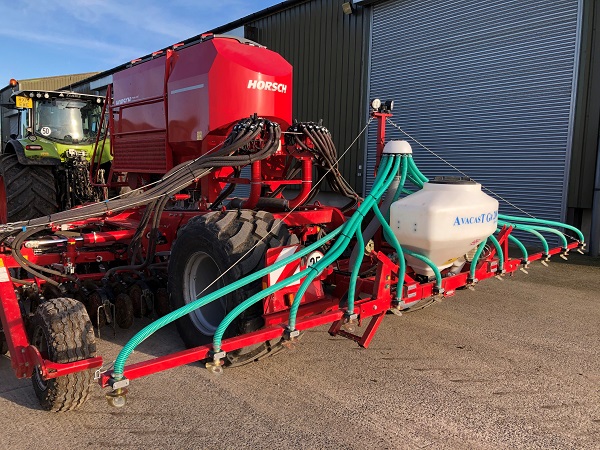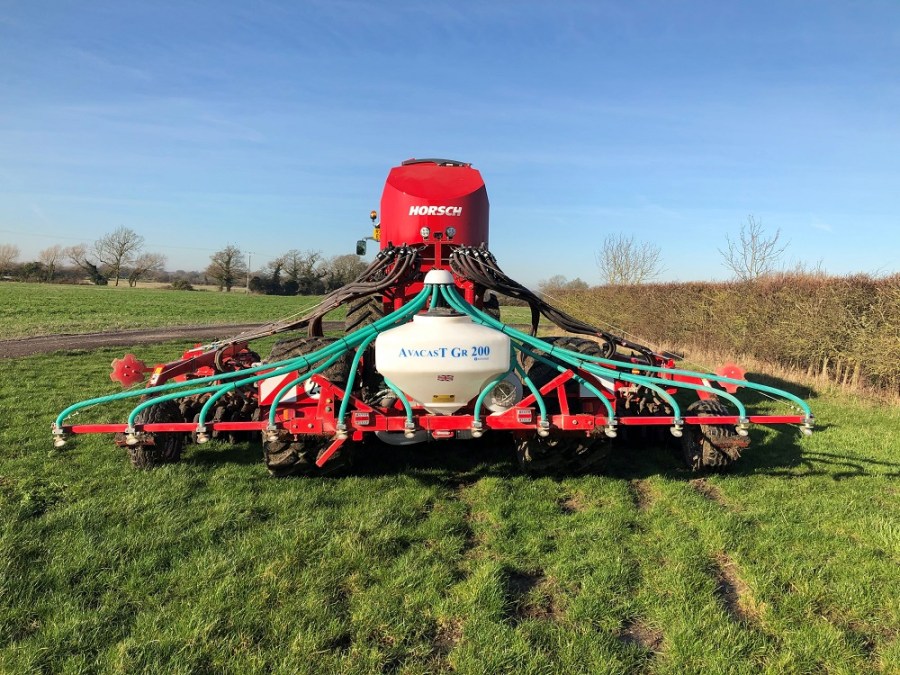Increasing blackgrass pressure has caused many growers to rethink their strategy in recent times. CPM talks to one farmer in Wilts who is successfully tackling his weed burden thanks to investing in a new Avadex applicator.
Our blackgrass situation is now manageable and under control.
By Rob Jones
Straddling the borders of Wilts, Oxon and Berks, Ashbury Farm has seen, experienced and dealt with its fair share of change during the last 85 years – which is now run by brothers Tom and Bill Spence.
However, in recent times one subject has dominated the conversation above all others and Tom sounds slightly deflated as he says he readily admits that blackgrass ranks as one of the greatest agronomic challenges the farm has seen.

Tom and Bill approached agricultural dealer Claas Western of Cirencester who designed and fabricated a new 6m boom to carry the applicator’s fishtail outlets
And it was this very issue that led Tom and Bill to rethink their strategy on farm, including the investment of an Avacast GR 200.
“We know blackgrass isn’t going to go away and that has meant an overdue retreat to better cultural controls, later drilling, more flexible rotations and a return to the use of Avadex (tri-allate) – a product we hadn’t used for almost 20 years,” notes Tom.
A decade ago, like many other farms, Ashbury had become over-reliant on Atlantis (mesosulfuron+ iodosulfuron) without really considering other support systems to address their blackgrass issues. Rotations had narrowed as wheat and oilseed rape prices became the dominant economic drivers, so fundamental change was required.
“The first step we had to take in tackling blackgrass was widening our rotation,” explains Tom. “The majority of our farmed area is made up of three predominant soil types: Denchworth clay, easy-working chalk and downland.
“This diverse range of soils actually allows us to be more flexible in crop selection so we can be more market driven as a business, while still harnessing the agronomic benefits of a wider rotation.
“When I look at this year’s cropping, although we are still winter wheat dominant at 340ha, we are also growing significant areas of spring and winter barley, spring beans, spring and winter oats and spring wheat so the overall rotation is well balanced.”
As well as adding flexibility to their rotation, going back to the use of Avadex has also been a major stand in their strategy.
Avadex has been around for over 60 years, and while it hasn’t changed much chemically, application has always been said to be key to getting the best out of it. So Tom and Bill made the decision to invest in an applicator specifically designed to work alongside a drill.
“Influenced by neighbouring farms who had also begun to use either a drill or rolls mounted applicator, we eventually settled on the Avacast GR 200 from Cambridgeshire-based Techneat Engineering as the best option,” explains Tom.
However, with the way their drill was designed, there was nothing to mount the Avacast on to, so they approached agricultural dealer Claas Western of Cirencester who designed and fabricated a specialist new 6m boom to carry the applicator’s fishtail outlets and swings out over the back of the coulters, he adds.
The Avacast GR 200 is a granular applicator specifically designed for applying Avadex micro-granules.
It features a compact 200-litre hopper and is commonly mounted on rolls, drill, or on a utility vehicle, according to manufacturer, Techneat Engineering.
But how exactly does it work?
The powerful hydraulic fan provides air to deliver Avadex at widths of up to 12m, explains the firm. “The twin spreader plates have outlets at – ideally – 500mm apart, giving double overlap from each spreader plate to its neighbour.
“It’s supplied with a slug pellet metering system so that you have the option of controlling slugs in areas where blackgrass and wild oats are not problematic.”
According to Tom, it was a simple set-up on the drill’s new boom, with spreader plates positioned every 500mm providing double overlap and even distribution.
The Avacast GR spreader plates are also positioned well behind any soil disturbance from the drill’s discs so that no Avadex-to-seed contact occurs during drilling, he adds.
“It’s a very straightforward machine, easy to calibrate and delivers a high level of accuracy. The hopper is well positioned for easy refilling and the Avacast’s metering is matched to the forward speed of the drill to maintain the integrity of the spread pattern.
“In good conditions we can apply up to 50ha of Avadex per day while drilling, although output is tempered by our smaller field sizes.”
For establishment, Ashbury Farms currently use two main systems: minimum tillage and direct drilling.
All crops are drilled using a 6m Horsch Pronto NT disc drill that keeps surface disturbance to a minimum, ensuring that any blackgrass seeds are kept in the top 3-4cm of the soil where they can be dealt with more effectively as they germinate, explains Tom.
“The Pronto NT is a compact universal seed drill that’s ideal for either a min-till or no-till system. Beyond accurately drilling the crop, all we want to do is encourage germination of the weed seeds then deal with them via our pre-ems, along with Avadex, which we apply in the same pass as the crop is drilled.
“Although the current thinking is to get Avadex onto the seedbed within 48 hours of drilling our approach actually ensures the Avadex goes on simultaneously. This eliminates the need to use a specialist Avadex contractor and is substantially better for soil health with one less pass” he notes.
Fast forward to today and Tom describes the farm’s blackgrass situation as manageable and under control, albeit with ongoing re-assessment and discussion with their agronomist on a regular basis.
“The changes we have made – particularly during the past two years and including a change in our agronomic advice – have certainly all helped, but it’s an ongoing process and we take nothing for granted.”
Going forward, Tom says they are currently looking at a return to growing OSR with a Clearfield variety this autumn. “It will be interesting to see what effect this has on our overall rotation and our current grassweed pressure. We’re also going into a mid-tier stewardship scheme with a cover crop approach sowing clover to replace winter stubble.”
The recent investment in the Avacast GR 200 could help on both accounts here, he adds. “We can potentially use it to spread slug pellets whilst establishing the rape – and to spread the clover seed – simply by changing the machines existing roller to a fine seed roller, so it could prove to be a very advantageous investment.”
Advice on Avadex
Originally brought to market for grassweed control by Monsanto in the 1960s, Avadex is now manufactured by Gowan.
Tri-allate – the active ingredient in Avadex – is a thiocarbamate and works by inhibiting lipid synthesis. When applied to the soil, the product forms a chemical barrier through which germinating weeds have to grow. They then subsequently absorb the chemical and are killed.
This year, there are concerns that blackgrass emergence is likely to be impacted by the very wet conditions, as a result of autumn germination being delayed by induced dormancy in wet soil — instead, germinating in spring when the soil dries out.
As well as this, according to ADAS monitoring, blackgrass seed dormancy was relatively high. The question is: Where does this leave growers?
In a bid to help growers get the best from Avadex, Gowan has some advice on how the product could be a useful aid to growers this spring as well as key things to consider when it comes to applications.
“Typically we see 15-20% of blackgrass populations germinating in spring,” explains Barrie Hunt, UK and Ireland technical manager at Gowan. “Levels this spring are likely to be well above this, and so growers ought to be planning ahead and thinking about which chemistry is going to be most effective.”
According to Barrie, the main barrier to achieving robust control is a lack of available, effective chemical options. “The vast majority of pre-emergence herbicides have greatly reduced spring application rates, with individual flufenacet products being limited to rates delivering just 120g/ha of active — that’s 50% of the autumn blackgrass rate.”
Alongside some of the pendimethalin-containing products, Barrie believes both Avadex Factor and Avadex Excel 15G (triallate) could help give growers the edge over blackgrass this spring. “Both Avadex products deliver a full effective grassweed dose at all cereal drilling dates — autumn or spring,” he explains.
In terms of crop suitability, Avadex Excel 15G can be used on both spring barley and spring wheat, while Avadex Factor is suited solely to spring barley, he adds. “In spring barley both Factor and 15G can be used either pre-drilling or post-drilling pre-emergence. This really widens the application window, allowing more time to get it on, without affecting performance.”
As well as putting up a fight against blackgrass in spring cereals, Avadex is also authorised for use on spring linseed and has proven itself to do a great job on wild oats too, he adds. “Both Factor and 15G can be used under an EAMU. This makes them the only non-ACCase blackgrass/wild oat product available for this crop.”
While the product has the potential to be very effective, to get the best out of it, it must be applied correctly, explains Kuldip Mudhar, development manager at Gowan. “A very important part of using Avadex is applying it correctly – if you don’t, you’re likely to end up with stripes of grassweeds across the field.”
Given that application requires the use of specialist kit, growers may be tempted to use a contractor to save on investment. However, this has both pros and cons to consider, adds Kuldip. “Given the time pressures faced by farmers, a contractor may be a useful option. If you’ve got a good contractor who will come at the right time – at pre-emergence – then use one.
“Getting it on at the right time is critical – once the crop has emerged, Avadex’s effect is greatly diminished. So another option is to apply it yourself.”
For those going down the self-application route, the mounting of the applicator can make significant difference to the product’s efficacy.
Some growers choose to mount it on a tractor, others on the drill, and some prefer to tow it or mount it on an ATV. But where is the best place?
“As with all pre-em products, you need a consolidated, firm seedbed, so products are normally applied after the last cultivation,” explains Kuldip. “That firm seedbed is key, so I can see why people apply it via a separate operation – they drill, roll and then apply – but if you think you’ve got a good consolidated seedbed, put it behind the roller or drill.”
Though he doesn’t claim Avadex is a silver bullet, Barrie believes it could be a useful part of the solution — particularly this season. “There’s no doubt it’s going to be a challenging year. However, with proper planning, and by optimising the most effective products, growers should hopefully be able to put themselves in a much stronger position heading into harvest 2020.”
Farm facts
Ashbury Farms, Ashbury, Swindon
Arable area: 800ha
Crops: Wheat, winter and spring barley, winter and spring oats, spring beans
Mainline tractors: Claas 810 Axion and 640 Arion
Combine harvester: 750 Claas Lexion Terra Trac
Sprayer: Horsch Leeb trailed 5000 litres
Cultivations: Horsch Pronto NT
Soil type: Denchworth clay, easy working chalk and downland
Staff: Brothers, Tom and Bill Spence.




